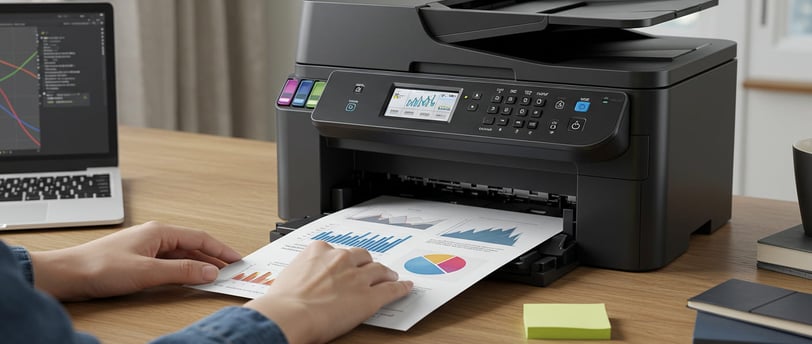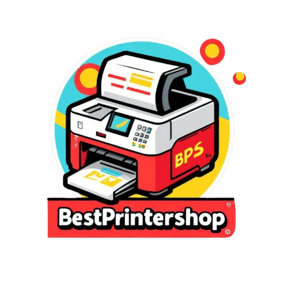10 Must-Have Home Printer Features for 2025
Looking for a new home printer in 2025? Discover the 10 essential features you need to consider before making your purchase, from connectivity to eco-friendly options.
5/18/20256 min read


The home printer market has undergone significant changes in recent years. Gone are the days when a basic inkjet printer would suffice for the occasional document. Today’s home office setups require versatile, efficient, and cost-effective printing solutions capable of handling everything from standard documents to high-quality photographs and creative projects.
As we progress through 2025, printer technology continues to advance rapidly, offering features that were once reserved for professional-grade equipment. Whether you’re working from home, running a small business, or simply need a reliable printer for everyday use, understanding the key features to look for will help you make a well-informed choice.
This comprehensive guide outlines the 10 essential features to consider when buying a home printer in 2025, helping you navigate the crowded market and find the perfect match for your specific needs.
1. Connectivity Options
Wireless Capabilities Are No Longer Optional
In today’s connected home, a printer without wireless connectivity is virtually obsolete. Modern printers should offer multiple connection options to suit your workflow:
Wi-Fi Direct: Enables printing directly from devices without needing a wireless network
Bluetooth: Convenient for quick prints from mobile devices
NFC (Near Field Communication): Allows tap-to-print functionality from compatible smartphones
Cloud Printing: Access and print documents stored in cloud services such as Google Drive, Dropbox, or OneDrive
The latest models in 2025 feature enhanced connectivity stability and simplified setup processes, making wireless printing more reliable than ever. Many now include dedicated mobile apps that let you monitor ink levels, adjust settings, and troubleshoot common issues directly from your smartphone.
According to a recent survey by PrinterTech Magazine, 87% of home printer users now consider wireless connectivity an essential feature, with cloud printing capabilities closely following at 72%.
2. Print Quality and Resolution
Finding the Right Balance for Your Needs
Print resolution, measured in dots per inch (dpi), determines the clarity and detail of your printed materials. Different purposes require varying resolution abilities:
Text documents: 600 dpi is generally sufficient
Basic graphics: 1200 dpi provides good quality
Photos and detailed images: Look for 4800 dpi or higher
Many 2025 printer models now feature adaptive resolution technology that automatically adjusts to the content being printed, optimising both quality and ink usage. This is particularly useful for mixed-use households where printing needs vary widely.
When evaluating print quality, don’t rely solely on specifications—request sample prints from the models you’re considering. This hands-on approach will give you a better sense of actual output quality than figures alone.
3. Print Speed and Efficiency
Time Is Money—Even at Home
Print speed, measured in pages per minute (ppm), has become increasingly important as home offices become more common. Modern printers should offer:
Document printing: At least 15–20 ppm for black and white
Colour documents: Minimum 10–15 ppm
First page out time: Under 10 seconds for optimal efficiency
The latest 2025 models feature improved startup and processing times, reducing the wait between sending a document to print and receiving the completed page. Some newer models also include queue management features allowing you to prioritise urgent print jobs when multiple people use the printer.
Bear in mind that advertised print speeds are typically based on draft-quality settings. For higher-quality outputs, expect somewhat slower performance. Consider your typical usage when assessing whether a printer’s speed will meet your needs.
4. Running Costs and Ink Efficiency
Looking Beyond the Purchase Price
Perhaps the most overlooked aspect of buying a printer is calculating long-term running costs. The purchase price is just the start—ink or toner expenses quickly exceed the initial outlay.
New printer models in 2025 have made significant strides in reducing running costs:
Ink subscription services: Many manufacturers now offer monthly plans that automatically deliver ink before you run out
High-capacity tanks: Increasingly popular ink tank systems can print thousands of pages before needing refills
Efficient ink usage: Advanced print heads use ink more economically without sacrificing quality
Draft modes: Improved quality of economical print settings for non-critical documents
According to Consumer Print Reports, the average cost per page varies dramatically between models, ranging from 2p to 15p per colour page. Before committing to a purchase, calculate the estimated cost per page based on your typical monthly print volume.
Some eco-tank printers now offer running costs below 1p per black and white page—a game-changer for high-volume home users.
5. Multifunction Capabilities
Beyond Basic Printing
Modern home printers are expected to do much more than just print. Look for models that offer:
Scanning: At least 1200 dpi optical resolution for clear digital copies
Copying: Quick standalone copying without the need for a computer
Faxing: Still relevant for some professional and legal documents
Document feeding: Automatic document feeders for multi-page scanning and copying
The latest multifunction printers (MFPs) in 2025 feature enhanced scanning capabilities with text recognition (OCR) that converts scanned documents into editable text. Some premium models now include AI-powered document classification that automatically organises scanned papers into appropriate digital folders.
When considering multifunction features, assess which capabilities you’ll actually use. If you rarely scan documents, a basic printer might suffice. However, if you frequently work with paper documents, investing in a capable MFP can significantly boost your productivity.
6. Paper Handling and Media Support
Versatility for Different Projects
Your printer should accommodate the various media types you regularly use. Modern printers should offer:
Multiple paper trays: Separate trays for different paper sizes or types
Specialty media support: Ability to handle card stock, envelopes, labels, and photo paper
Borderless printing: Essential for photos and marketing materials
Duplex printing: Automatic double-sided printing to save paper
The newest 2025 models feature improved paper path designs that reduce the likelihood of jams when using specialty media. Some premium home printers now include dedicated photo paper trays with light-blocking covers to protect photo paper from dust and light exposure.
Consider the maximum paper weight (measured in gsm – grams per square metre) that the printer can handle. Standard document paper is typically 80 gsm, while cards and specialty papers range from 160 to 300 gsm. Ensure your chosen printer can manage the thickest media you plan to use.
7. Size, Noise Level, and Design
Practical Considerations
As home spaces often serve multiple purposes, the physical characteristics of your printer matter:
Footprint: Measure your available space before shopping
Noise level: Look for models advertising quiet operation (under 50 dB)
Design: Consider whether the printer will be visible in living areas
Display panel: Touchscreens offer easier navigation than button-only interfaces
Modern printer designs in 2025 have become more compact and aesthetically pleasing, with many manufacturers offering models in various colours to match home décor. Some premium models now feature acoustic dampening technology that significantly reduces operational noise.
Don’t underestimate the importance of a good user interface. A well-designed touch panel can make all the difference in everyday usability, especially for less tech-savvy household members.
8. Smart Features and Voice Control
Printers Join the Smart Home
As smart home technology becomes ubiquitous, printer manufacturers have integrated convenient features:
Voice assistant compatibility: Support for Amazon Alexa, Google Assistant, and Apple Siri
Scheduled printing: Set regular print jobs to run automatically
Usage monitoring: Track printing patterns and set limits for different users
Preventative maintenance: AI-powered systems that detect potential issues before failures occur
The latest 2025 models include enhanced voice command capabilities that go beyond basic printing functions. You can now check ink levels, run cleaning cycles, or scan documents to specific locations using natural language commands.
Smart features not only improve convenience but also help manage printing costs by providing detailed usage analytics and optimising maintenance schedules.
9. Security Features
Protecting Your Digital Information
Printer security has become increasingly important as these devices connect to home networks:
Secure printing: PIN protection for sensitive documents
Data encryption: Protection for documents in transit to the printer
Network security: Safeguards against unauthorised access
Automatic firmware updates: Regular security patches and improvements
Modern printers in 2025 now include advanced security protocols such as biometric authentication for releasing sensitive print jobs and automatic document erasure from internal storage after printing. Some models feature isolated network processors to prevent printer vulnerabilities from being exploited to access your home network.
Don’t underestimate the importance of printer security, especially if you work with confidential information or share your printer with multiple users.
10. Environmental Considerations
Eco-Friendly Printing Options
Sustainability has become a key consideration for many consumers:
Energy efficiency: Look for Energy Star certification
Eco modes: Settings that reduce power consumption during idle periods
Recyclable consumables: Programs for returning and recycling ink cartridges
Responsible manufacturing: Brands with transparent environmental policies
The latest printers in 2025 feature improved power management systems that can reduce electricity usage by up to 40% compared to models from just five years ago. Many manufacturers have also introduced cartridges made from recycled plastics and biodegradable packaging materials.
Some innovative models now include carbon footprint trackers that estimate the environmental impact of your printing habits and suggest ways to reduce waste.
Conclusion: Choosing the Right Printer for Your Home
Selecting the ideal home printer in 2025 involves balancing your individual needs with the available features and your budget. Think about how you’ll mainly use the printer, how often you’ll be printing, and which special features would genuinely enhance your experience.
Bear in mind that the cheapest printer can often end up being the most costly in the long term due to expensive ink. Investing in a good-quality printer with efficient ink usage can save you a considerable amount of money over time, especially if your household prints frequently.
Before making your final choice, be sure to read up-to-date user reviews of the models you’re considering, as these can highlight real-world performance issues that specifications alone might overlook.
Which features do you find most important in a home printer? Share your thoughts in the comments below, or if you’ve recently bought a printer, tell us which features you find most useful in your everyday life.
Insights
Explore the latest in printer technology and tips.
Resources
Support
contact@bestprintershop.com
+918920029543
© 2024 BestPrinterShop . All rights reserved.
